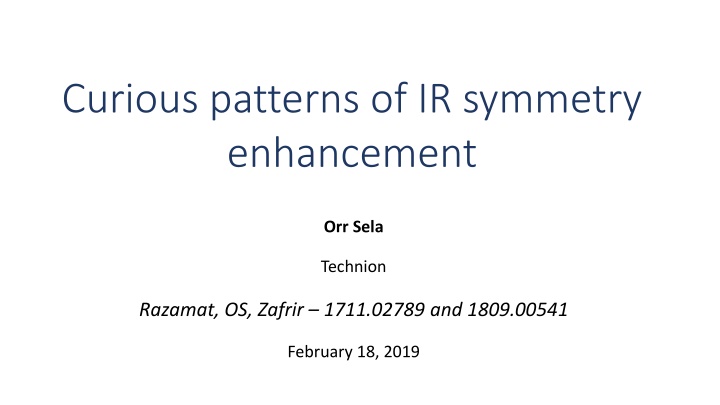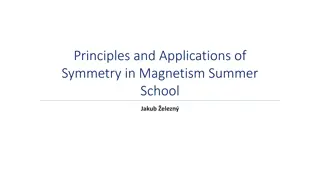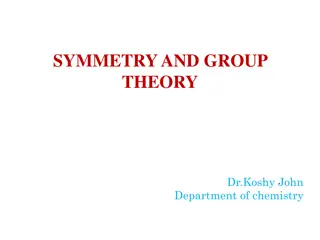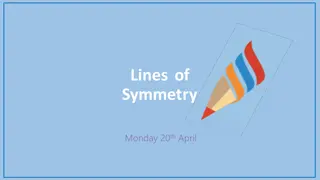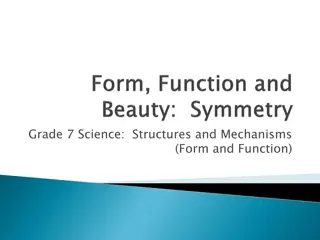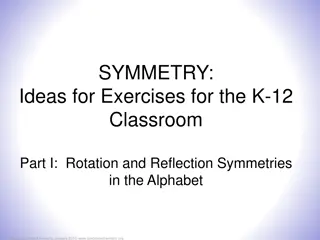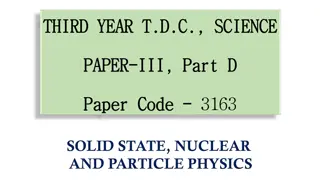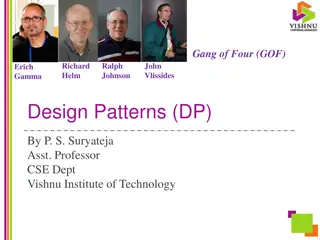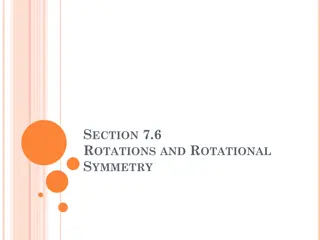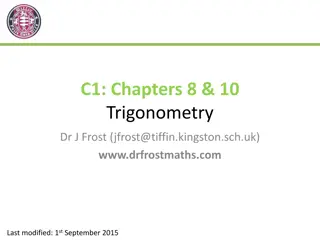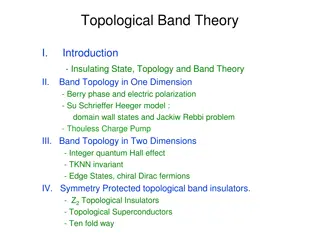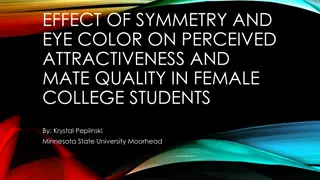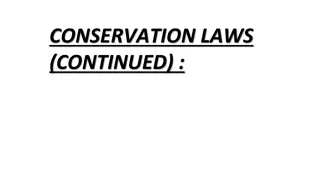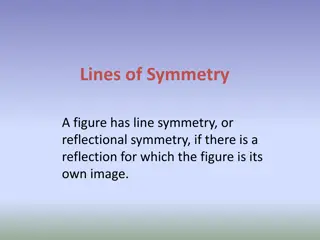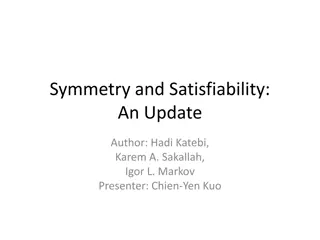Curious Patterns of IR Symmetry Enhancement
Unravel the unique phenomenon of IR symmetry enhancement in theoretical frameworks, exploring enhancement patterns and underlying mechanisms. Delve into novel models through self-dualities, utilizing superconformal indices to identify origins and generate new insights.
Download Presentation

Please find below an Image/Link to download the presentation.
The content on the website is provided AS IS for your information and personal use only. It may not be sold, licensed, or shared on other websites without obtaining consent from the author.If you encounter any issues during the download, it is possible that the publisher has removed the file from their server.
You are allowed to download the files provided on this website for personal or commercial use, subject to the condition that they are used lawfully. All files are the property of their respective owners.
The content on the website is provided AS IS for your information and personal use only. It may not be sold, licensed, or shared on other websites without obtaining consent from the author.
E N D
Presentation Transcript
Curious patterns of IR symmetry enhancement Orr Sela Technion Razamat, OS, Zafrir 1711.02789 and 1809.00541 February 18, 2019
Contents Background and Motivation New patterns of symmetry enhancement 6? constructions Summary and future directions
Background symmetry enhancement UV In some theories the UV symmetry enhances in the IR: ???(?global) > ???(?global) IR
Example SU(2) Seiberg duality ?? 2 , ??= 4 , ? = ?? ? (4) G SU = ?? 2 , ??= 4 = (2) global (4) (1) SU U (1) global G (8) SU IR (2) global G (1) global G
Natural questions For a given UV theory, is there a criterion for IR symmetry enhancement? Is there an organizing principle for theories with IR symmetry enhancement? What is the general mechanism behind this phenomenon?
In this lecture Concentrate on 4? theories with = 1 supersymmetry. Use known (self-) dualities to generate both new and known models with symmetry enhancement. Identify the enhancement patterns and look for their origin in 6?. Our main tool will be the superconformal index
The superconformal index in 4d Given by a trace over the states of the theory quantized on ?3 : ? ?,?;{??} = Tr?3 ( 1)?? ????1+?2+? 2??2 ?1+? ???? 2 ? ? Fermion number. ?1, ?2 Cartan generators of the ??(2)1 ??(2)2isometry group of ?3. ? R charge. ??, ?? Fugacities and charges of the global symmetries. ? ?,? = ? 2?2 3 2?. Only ? = 0 states contribute.
Properties of the index Invariance under RG flow Index of IR theory from a calculation in the UV. [Romelsberger 07; Kinney, Maldacena, Minwalla, Raju 07; Festuccia, Seiberg 11] At order ?? in the expansion of the index [Beem, Gadde 12]: ? = 1 + + # ?? + # = Marginal operators Conserved currents
From (self-) dualities to symmetry enhancement Self-dualities (i.e. between theories with the same gauge sector) can be utilized to find theories with an enhanced symmetry by constructing models which are structurally invariant under them. Consider e.g. an SU(4) gauge theory with 4 flavors ?, ? and 2 antisymmetric fields ?: ?? 4 + 4( + )+2
?? 4 + 4(+ )+2 The global symmetry is: ?? 42 ??(2) ? 12 This model has multiple self-dual descriptions [Csaki, Schmaltz, Skiba, Terning 97]. By adding gauge-singlet fields ?,?, and the superpotential ? = ?? ? + ???2+ ?2 we get a model which is structurally invariant under most of the dualities.
?? 4 + 4(+ )+2 +?,?, The index of this model at order ?? is given by: ???? 41 ???? 42 ??? 41??? 42 ??? 2 2 = ???? 12 ??? 2 2 ?? 42 ??(2) ? 12 ??(12) ??(2) ? 12
Generalization Spin(n+4) sequence We can look at our original ??(4) theory as the ????(6) model in a sequence of ????(? + 4) (1 ? 8) models with matter content in the spinorial and vector representations [Csaki, Schmaltz, Skiba, Terning 97]. Each model in the sequence has at least one self-dual theory. Adding to each model appropriate gauge-singlet fields and superpotential (as before), one can form a ????(? + 4) sequence of theories with symmetry enhancement.
Symmetry enhancement in the Spin(n+4) sequence Gauge group ????(5) UV symmetry ??(8) ? 1 ?? 42 ??(2) ? 12 ?? 4 ??(3) ? 1 ?? 22 ??(4) ? 12 ?? 2 ??(5) ? 1 ?? 2 ??(6) ? 1 ??(7) ? 1 ??(8) ? 1 IR symmetry ?7 ? 1 ??(12) ??(2) ? 12 ??(6) ?? 32 ? 1 ??(2) ?? 43 ? 1 ??(3) ?? 52 ? 12 ??(3) ?? 62 ? 1 ?? 72 ? 12 ?? 82 ? 1 ????(6) ????(7) ????(8) ????(9) ????(10) ????(11) ????(12)
Generalization SU(2n) sequence The IR symmetries in the ????(? + 4) sequence are given by:* [Commutant of ?? ? ?? 2 in ?8] ?? ?2 ?(1) We can look at our original ??(4) theory as part of a different sequence of models with self-dual descriptions: ?? 2? + 2? + 8 2? + 2 ? = (1,2,3,4) We can again add gauge-singlet fields and superpotentials to form a sequence of models with symmetry enhancement.
Symmetry enhancement in the SU(2n) sequence Gauge group ??(2) UV symmetry ?? 6 ??(2) ? 1 ?? 42 ??(2) ? 12 ?? 22 ??(6) ? 12 ?? 2 ??(8) ? 1 IR symmetry ?6 ? 1 ??(12) ??(2) ? 12 ??(2) ?6 ? 12 ??(2) ?7 ? 1 ??(4) ??(6) ??(8)
6d construction Spin(n+4) sequence Idea: 6? theory + compactification 4? models + enhanced symmetries at IR We find (by going through 5?) the following 6? theory: Gauge ??(?) ?8in E-string and add 2? fund hypers + a tensor multiplet Infinite coupling limit origin of tensor branch of the desired SCFT.
6d construction Spin(n+4) sequence The global symmetry of the 6? theory: [Commutant of ?? ? in ?8] ??(2?) Conjecture: Compactifying on a torus with fluxes + relevant deformation ?? 2? ?? ?2 ?(1) and above commutant [commutant of ?? 2 in it] ????(? + 4) sequence + IR symmetries Was demonstrated explicitly for ? = 1 and ? = 2.
6d construction SU(2n) sequence Similarly, the ??(2?) sequence can be obtained from torus compactifications with fluxes of 6? theories. The 6? theories are the (1,0) SCFTs with an ?7 ?? 23global symmetry of [Zafrir 18]. Upon compactifying these theories appropriately, we obtain the ??(2?) sequence and the IR symmetries.
Summary and future directions We have seen: (Self-) dualities Patterns of symmetry enhancement , 6? constructions Complete the explicit construction of the remaining 4? ????(? + 4) theories (? > 2) from 6? compactifications. Repeat this analysis for more theories with self-dual descriptions. An especially closely-related example is the ???? sequence of [Karch 97] which resembles the one considered here.
